Briefly - about Adomynė...
If you go along the highway Kupiškis - Utena, before entering the Anykščiai district, be sure to turn at Aluotimi to the cozy and beautiful village of Adomynės. In its very center, the heart of Adomynė is Mr. Adam's manor, one of the best-preserved wooden manors in Lithuania. Next to it , a gun-shaped pond , dug by the hands of mercenaries back in the days of the lords, is rustling in the old park of July. You will always be greeted hospitably by the lords of the manor, their maid will introduce you to the manor's architecture and the life stories of the old masters. Both young and old will find activities in the well-organized and well-maintained manor park: artistic wood and stone sculptures will remind you of the stories of the manor and its inhabitants, and after kissing on the Kissing bench in the Love Alley , you can also receive the blessing of the Goddess of Love Milda... If you wish, with the ethnographic ensemble you you will be able to have fun singing Lithuanian folk songs, learn ancient circles. Of course, you will be treated to local meals prepared by the wonderful hostesses: hearty royal wine and delicious Adominės "Pagrabinės" buns, which have been awarded the certificate of Lithuanian national culinary heritage , - you will not taste such delicacies anywhere else, because they have been served only in the Adominės manor and its surroundings.
Children can also have fun in Adomynė, because here they can learn to bake buns, play various games, go on a pontoon raft in the pond, and search for treasure .
Come and you will understand that our village is home to hardworking, creative and hospitable people who will try to make your stay in Adomyne pleasant and memorable.
Now the Kupiškis tourism and business center is located in Adomynės manor. You will be met by the tourism manager Virginija, who will introduce this object, you can buy souvenirs, leaflets and have a pleasant time with a cup of coffee or tea. At the moment, the building is being restored, craftsmen are working there, so we apologize in advance for the temporary inconvenience...
The History of Adomynė Manor. Layout, Architecture and Decor
Adomynė was first mentioned in 1555. Until the 19th century the area at the beginning was called Aluotėlės (Holoty Male, Olotki, Малы Голоты) and was a palivark of the Lithuanian noblemen Pliaterii Aluotki manor, and later the manor. Later owners of this manor wished to call it by their own names: Jonava , colloquially - Žurauskynė, Dankovietė, and finally - Adomynė.
J. Žurauskis 19th century in the thirties (1821-1830) he restored the rectangular, symmetrical building of the Aluotėlii manor with two vestibules in the central part and a large chimney and rooms at the ends.
After the reconstruction, the house became the residence of a large manor. The structure is given classical proportions and ornate interior decor. The shape of the extended "L" mansion and the interior layout have survived to this day. The preserved porches of the manor with canopies and beautiful wooden columns . The current tin roof was previously covered with shingles. A chapel was installed in one of the rooms of the manor until the Adomynės church was built.
After the First World War (in the second decade of the 20th century), the Aluotėlių-Jonavas manor began to be called Adomyne in honor of its last owner.
During the Soviet era, the manor was destroyed, restoration work began in 1990. in 2016 the pond has been cleaned, the shores have been repaired, and the beach has been installed. The exterior of the building is being restored in 2021. In 2019, thanks to the care of the local community, cozy recreation areas for children and adults were installed with functional sculptures, beach volleyball courts, outdoor exercise equipment, a well-kept park with a cozy Meilės alley and one of the most beautiful wooden architectural structures in Lithuania has already been adapted to the needs of the community and is open to everyone who wants to visit it. Concerts, meetings, celebrations are held in the great hall of the manor and in the cozy veranda, plein airs are organized, it is a great place for training and conferences. All visitors enjoy excellent acoustics and a warm atmosphere.
Conclusions of the Ethnographic Research of the Adomynė Manor Palace
In 1987, the ethnographer S. Daunys conducted the ethnographic research of the Adomynės manor palace.
There is no exact data on when the manor palace was built. The building has preserved many of the old 18th century. - 19th century structural and finishing elements. A very interesting combination of wooden and brick partition walls based on clear functions. Brick walls are not only the supports of the ceiling and other main structures, but also very important in solving the entire heating system. They have flues for stoves and fireplaces. An interesting plan of one building - it is divided by a wall into two parts: utility and production and living rooms. There are still characteristic features of the 19th century. double-doored filing doors, beautifully ornamented parquet floors, several Dutch-type brick ovens made of large white and green bricks with a hearth, bread oven, stoves, furnace, where a huge boiler was placed, storehouse with wooden shelves, cellars, etc. Zaizdras could have been used for the production of beer or mead, as the manor had a large apiary, and details of large wine bottles were found. The manor was engaged in the commercial production of intoxicating drinks. There were at least two bravuras in the manor, bitters, and vodka was transported even to Riga (the former owner of the manor, Barbora Vilėniškytė, remembers this).
Most of the rooms in the central part of the palace were decorated with decorative wall paintings. The basis of the wall decor is friezes, window and door frames, superport, panels. Ceilings are plafonds of complex composition, with rosettes in the centers. Painted on plaster with adhesive paint. Decorative wall painting was one of the main means of artistic expression of the palace interior. It is a monument of the artistic culture of romantic classicism.
Church of the Blessed Virgin Mary
Adomynė manor and surrounding manors belonged to Svėdasai, Šimonys and Skapiškis parishes. Adomynė itself belonged to Svėdasai parish. In order to get to the church, the inhabitants of this region had to walk or drive 8-15 kilometers. The owner of the Adomynė estate, Adomas Vilėniškis, who was famous for his charitable works, decided to build a church in Adomynė with his own funds. After receiving permits, in 1913 the construction of the church began, which was stopped by the outbreak of the First World War. After the death of the church's founder Adams Vilėniškis in 1921, his nephew priest Juozapas Vilėniškis continued the construction of the church. On October 23, 1921, the church was consecrated to St. In the name of the Virgin Mary. The church was 12 cubits long and 6 cubits wide, built of pine logs, and had three altars and two small sacristies.
The drawings of the church building were prepared by engineer A. Skrinikova. He was paid 200 rubles, and the total estimate for the construction of the church was 8479 rubles 2 kopecks. The founder of the church, Adomas Vilėniškis, donated 3,050 rubles, wrote down 20 tithes of land for the church, and half of the manor for the parsonage of the palace. About 1,200-1,300 residents of the area contributed to the construction of the church.
Big works were waiting for the interior of the church. It was necessary to install three altars, take care of paintings and other inventory. According to the income and expenditure book of Adomynė parish, in 1921, 44,620 auksins were paid to architect Nikitas for various works. In 1922, the painting "Our Lady of Anioli" was purchased for 1,300 gold coins, purchased at St. Anthony and St. Stephen's paintings for 40 gold rubles, in 1923 - a painting on the high altar "Prayer in the Nursery of Jesus V. Jesus" (author unknown) for 100 gold rubles. Most of the paintings in the church were painted by Igno Šlapelis (1881-01-31 – 06-03-1955), a relative of Gaspar Vilėniškis's second wife Karolina Šlapelytė, an art critic from the village of Bugailiškii (Kupiškis district). He used to visit Adams Vilėniškis's estate, he was in close contact with priest Juozas Vilėniškis. There are paintings of the Stations of the Cross, part of the altar paintings, in the Adomynė church. It is believed that the painting of the high altar "Holy Trinity" is also his work.
in 1928 Adomynė parish was formed in autumn and consecrated St. On behalf of M. Maria.
In 1935, construction of a hospital (parish house) began near the church. Kazimieras Lapienis, a farmer from the village of Vadonių, took care of its construction. Parishioners donated wood and money for the construction. Built by local craftsmen. In the parish house, there lived the organist and the caretaker of church clothes and the church, called "pročka". A parish hall was presented near the hospital, where members of various organizations and young people gathered, concerts and plays were held. After the Second World War, the hospital was nationalized. Half of the manor palace, which belonged to the rectory, was also nationalized. Adominės neighborhood, library, Adominės collective farm office, medical center, post office were located in these premises. The priest lived in the part of the mansion that belonged to Barbora Vilėniškyta. 1960 pastor Antanas Vaškevičius built a new rectory and moved into it.
Adomynė parish belonged to Utena deanery, in 1926 it had 2085 Catholics. According to the "Alphabetical List of Villages" compiled in 1934 by pastor Juoz Vilėniškis, Adomynė parish had 382 yards and 1991 people lived there. In 2001, 795 people belonged to the parish.
Canon Juozapas Vilėniškis (1873 – 1952), priest Aloyzas Raugalė (1911 – 1942) and exiled pastor Steponas Pelešynas (1908 – 1984) are buried in the Adomynės churchyard. The founder of the church, Adomas Vilėniškis, his brother Gaspar with his family, Gaspar's children Uršulė, Barbora, Antanas and Elena are buried in Adominės cemetery. Adomynė rests in the parish cemetery on November 1, 1949. of the killed "Algimanto" district commander Antanas Starkaus-Montė, his adjutant Julius Burneikas-Tardytojs, chief of staff Albinos Pajarskas-Bebros, head of the organization department Aleksas Matelios-Audenis, ordinary partisans Jonas Stukas, Juozas Mazurevičius, Birutė Šniuolytė-Ida-Ramunė, Stase Vigelytė -Animal bodies. A monument was erected in the year of revival, and in September 1990, a cross was erected in the cemetery of Adomynės church to commemorate the restoration of Lithuania's independence.


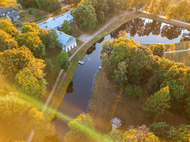
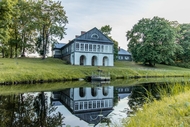
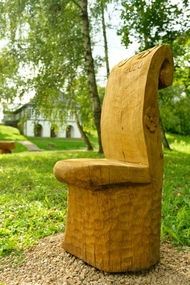
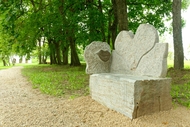
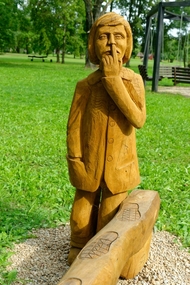
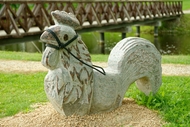
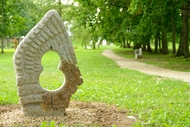
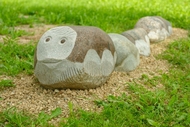
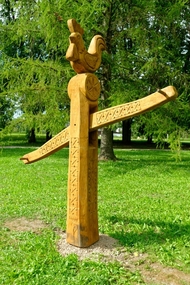
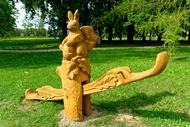
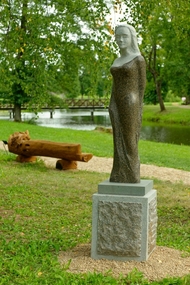
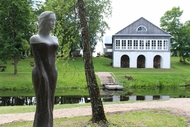
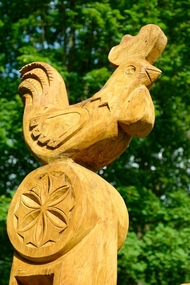
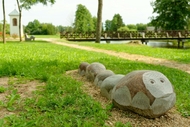
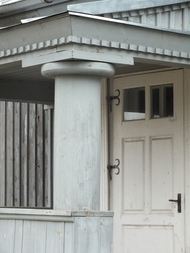
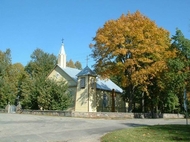
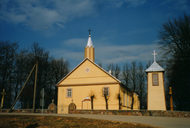
.jpg)